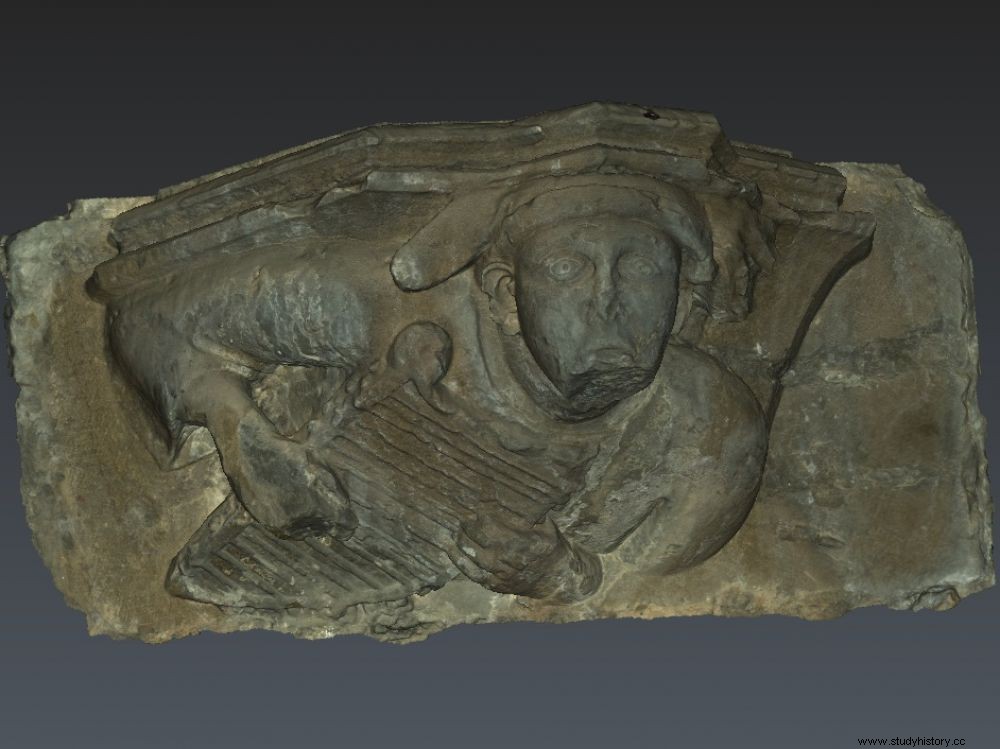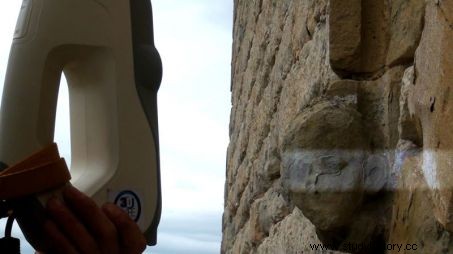Archaeo-luthery specialists have carried out research on the ancient instruments represented in sculpture in the dungeon. They discovered that one of them, unknown until then, had really existed.

A digital model of the psaltery in shield of the music room of the castle of Puivert, in Aude.
In the 14th century, this peculiarity of the castle of Puivert (Aude) was scandalous. In the square and massive keep, which makes the silhouette of this building so recognizable used in the film The Ninth Gate by Roman Polanski, the levels dedicated to Christian worship are located at the bottom and not at the top as traditionally. A real insult. Especially when you know that the top is occupied by a piece of music. This vaulted room is decorated with eight instruments sculpted on the culs-de-lampe. However, if seven of them were known to specialists (such as the bagpipes, the lute, the fiddle, the tambourine), the eighth has long been taken for a symbolic representation. It is an instrument with 18 courses of two strings called a psaltery but whose shape was unknown, documented nowhere. But Julian Cuvilliez and Audrey Lecorgne, Atelier Skald luthiers and researchers in archaeo-musicology who have been studying this instrumentarium for nearly ten years, have demonstrated that it did indeed exist.
At 14 th century, this peculiarity of the castle of Puivert (Aude) was scandalous. In the square and massive keep, which makes the silhouette of this building so recognizable used in the film The Ninth Gate by Roman Polanski, the levels dedicated to Christian worship are located at the bottom and not at the top as traditionally. A real insult. Especially when you know that the top is occupied by a piece of music. This vaulted room is decorated with eight instruments sculpted on the culs-de-lampe. However, if seven of them were known to specialists (such as the bagpipes, the lute, the fiddle, the tambourine), the eighth has long been taken for a symbolic representation. It is an instrument with 18 courses of two strings called a psaltery but whose shape was unknown, documented nowhere. But Julian Cuvilliez and Audrey Lecorgne, Atelier Skald luthiers and researchers in archaeo-musicology who have been studying this instrumentarium for nearly ten years, have demonstrated that it did indeed exist.
"This psaltery has an atypical shape, in shield, explains Julian Cuvilliez. We know that sculptures are not always faithful to reality. Often made from memory by medieval craftsmen, they sometimes contain errors, as was long believed for Puivert's psaltery."
Added to this are constraints due to the material, pushing the craftsman to take liberties with his model. Not to mention that some representations are not intended to depict reality but have a more symbolic significance. "The instrumental representations of the musicians' room were made by a master craftsman from Mirepoix. A precise, proportionate work, which does not fall within a symbolic register. There was no sense in the one of the subjects of this collection, as strange as it may be, may have been an exception. This observation was the starting point of our work at Puivert."
Julian Cuvilliez and Audrey Lecorgne therefore carried out their research by correlating different European databases, non-existent at the time of the first records of Puivert, to end up finding three other references to the instrument as it appears at the Château de Puivert. The first is from an illumination of the 13 th century depicting a medieval version of the banquet of Ahasuerus (a biblical scene), kept at the Royal Library of Belgium (manuscript 281). The second is a description of the shield psaltery in a text by the theologian Jean de Gerson (1363-1429). The shield shape, reminiscent of a heart, would make the instrument suitable for "singing the praise of God", which inscribes it in a sacred register.
Finally, a very similar psaltery (atypical form, similar cordage) appears in the painted decoration of the Saint-Antonin chapel of the conventual ensemble of the Jacobins in Toulouse.
Pinched strings, bowed strings
The term psaltery actually refers to a whole family of instruments (some were played with plucked strings, others strummed with a plectrum). "If the 'shield' form is so poorly documented, notes Julian Cuvilliez, it is probably due to the fact that between the 12 e and 14 e century, another instrument would make a major breakthrough in the medieval musical landscape and eclipse many instruments:the harp."

The work of Atelier Skald did not stop there. On the strength of their discovery and thanks to an experimental archeology protocol, the two researchers reconstructed a playable shield psaltery using reconstructed tools and with the species of wood probably used at the time of the 16th century. century (spruce and walnut), identified through palynology (see here). In 2014, they also led a mission within the Center for Research, Interpretation and Experimental Archeology to scan in 3D all the sculptures of the Puivert instrumentarium as well as six others adorning the exterior facades of the keep. Located thirty meters high, the latter were until then inaccessible and unknown. All these objects have been transformed into digital models available and easily manipulated for researchers
